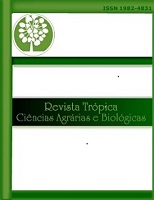NON-CONVENTIONAL FOOD PLANTS AS AN ALTERNATIVE FOR FOOD DIVERSIFICATION
Keywords:
unconventional food, recipe development, vegetables speciesAbstract
People use natural resources, especially of plant or animal origin, to satisfy their nutritional needs, with the contribution of plants being extremely relevant, but there is still a need to diversify plant sources. In this context, Non-Conventional Food Plants (PANCs), which are plant species that have one or more edible parts, whether spontaneous, cultivated or exotic and that are not included in our usual menu, are still neglected in their potential use. The present work aimed to disseminate knowledge among students at the IFPI campus Picos and other schools in the region, as well as to users of social networks about these plants, using methodologies that range from the collection and processing of botanical material to the production of informative posters to be disseminated virtually and preparation of recipes to assist in the dissemination of information about
PANC's. A total of twenty plants were collected and photographed, of which 10 were selected to produce the recipes. A profile was created on the social network Instagram to publicize recipes and botanical information about the species. We consider it important to disseminate data via social networks and people's feedback was important to understand that the information was objectively spread.
Downloads
References
KINUPP, V. F.; LORENZI, H. Plantas Alimentícias Não Convencionais (PANC) no Brasil – guia de identificação, aspectos nutricionais e receitas ilustradas. 2014.
KINUPP, V. F. Plantas Alimentícias Não-Convencionais da Região Metropolitana de Porto Alegre, RS. Porto Alegre. 562 p. 2007. Tese - (Doutorado em Fitotecnia). Disponível em: http://hdl.handle.net/10183/12870. Acesso em 05 de Julho de 2023.
MINISTÉRIO DA SAÚDE. 2014. Guia Alimentar para a População Brasileira. Brasília - DF. 2ª edição, 1ª reimpressão, 158p. Disponível em: https://bvsms.saude.gov.br/bvs/publicacoes/ guia_alimentar_populacao_brasileira_2ed.pdf. Acessado em 03 de Julho de 2023.
MORI, A. S.; SILVA, L. A. M.; LISBOA, G.; CORADIN, L. Manual de Manejo do Herbário Fanerogâmico. Centro de Pesquisa do Cacau, Ilhéus. 2 ed., 1-44, 1989.
PINTO, A. C.; BOLZANI, V. S.; LOPES, N. P.; EPIFANIO, R. A. Produtos naturais: Atualidade, desafios e perspectivas. Quim. Nova, v. 25, Supl. 1, 45-61, 2002.
POLESI, R. G.; ROLIM, R.; ZENETTI, C.; SANT’ANNA, V.; BIONDO, E. Agrobiodiversidade e segurança alimentar no Vale do Taquari, RS: Plantas Alimentícias Não Convencionais e Frutas Nativas. Revista Científica Rural, v. 19, n. 2, 118-135, 2017.
Downloads
Published
How to Cite
Issue
Section
License

This work is licensed under a Creative Commons Attribution-NonCommercial-NoDerivatives 4.0 International License.
Direitos autorais Revista Trópica: Ciências Agrárias e Biológicas
Este obra está licenciado com uma Licença Creative Commons Atribuição-NãoComercial-SemDerivações 4.0 Internacional.








